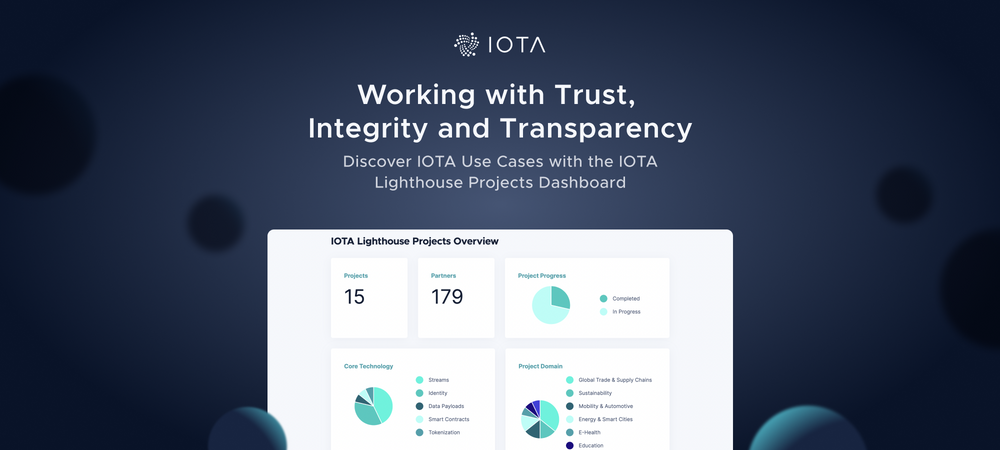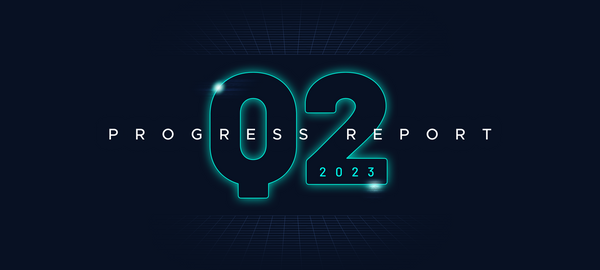Working with Trust, Integrity and Transparency
Discover IOTA Use Cases with the IOTA Lighthouse Projects Dashboard
TL;DR:
This blog post gives an overview of IOTA’s role in different use cases and explains how its unique features contribute to several lighthouse projects. The solutions developed in these projects are suitable for any industry that requires transparency, immutability, and secure data transfers. Our new lighthouse project dashboard provides a comprehensive overview of the projects along with the IOTA wiki of the tools developed, free for anyone to use and replicate to continue building on IOTA.
Gone are the days when IOTA’s catalog of projects could be summarized in a brief overview. Today, the Foundation is a crucial player in several public and private sector projects. Whether multi-year EU-funded collaborative research and development endeavors between a dozen organizations or projects carried out with a single partner, IOTA’s unique characteristics and frameworks make it an indispensable technology for different kinds of projects.
The versatility of IOTA makes it suitable for any field, as demonstrated by the sheer diversity of use cases among its projects, including audit trails for supply chain processes, monitoring, and different kinds of marketplaces. These lighthouse projects are torchbearers for the adoption of a technology that offers integrity and verifiability of data and value exchange.
To provide a comprehensive overview of IOTA’s lighthouse projects and demonstrate how its features are utilized, the Foundation has launched a new lighthouse project dashboard.
The dashboard includes a summary and key information about each project, such as consortium partners, timeline, and use cases, as well as links to the IOTA Wiki and information about the tools developed for each project.
The new project dashboard allows you to easily browse among our different kinds of projects through tags. For example, through the Sustainability tag, you can keep track of the Foundation’s projects focused on sustainability and keep your eyes open for the latest updates as well as shared development resources such as IOTA Wiki tools and GitHub repositories
Making a difference in digital measurement, reporting and verification
A leading example of an IOTA lighthouse project is DMRV (Digital Measurement, Reporting, and Verification). A collaboration between the IOTA Foundation and ClimateCheck funded by the Canadian government, DMRV democratizes access to environmental monitoring solutions and builds multi-stakeholder ecosystems based on open and transparent sustainability accounting. The DMRV project combines four different features:
- Standardized methodologies and protocols: for example, using smart contracts to automate requirements in digital MRV solutions.
- Online platforms and knowledge hubs to engage stakeholders to develop and harmonize MRV standards openly and transparently.
- A combination of digital technologies, such as digital sensors, DLT, and AI, to automate digital MRV standards for climate actions. For example, switching from household surveys for efficient energy solutions to IoT sensors.
- Generating data marketplaces to connect and support data owners, data providers, and users.
IOTA’s feeless protocol enables data transactions through digital sensors at the biodigester sites in Chile where the pilots are currently being implemented, measuring data related to (for example) the composition of gas, or electricity consumption levels. This data is stored on the Tangle securely and immutably without any charges incurred by the transactions. DLT-based projects like DMRV represent a shift from the manual collection and assessment of data to automated validation of data. These solutions generate trust, avoid green-washing, and drastically increase the revenue cycle, driving more investment in the sector.
Immutable and transparent real-time data: setting an example for sustainable mining with Dig_IT
IOTA’s contribution to sustainable practices and improving environmental impact is also harnessed in the Dig_IT project, funded by the European Commission. The project works on creating digital twins of mines to monitor the production of raw materials and the mines’ environmental impact. The goal is to improve the efficiency and sustainability of mining operations in an immutable and transparent way with a process and technology that later on can be replicated in different regions. The Dig_IT project develops and integrates oracles with an industrial IoT platform used in the mining industry to securely export trusted data across stakeholders (including the public). Not only does access to trusted and real-time machine and environmental data enable timely planning but also reaction and risk mitigation. Moreover, it increases the mining sector's efficiency and safety.
Not all DLT solutions are equal: Why IOTA is best in class for sustainability projects
Because of the high volatility in transaction fees, not all DLT projects are suitable for data transactions. Also, many DLTs are notorious for their excessive energy consumption and carbon emissions. For example, Ethereum uses an estimated 105.44 TWh annually at the time of writing, which is comparable to the total energy consumption of Kazakhstan. Using such energy-intensive protocols defeats the purpose of a solution intended to improve sustainability practices.
IOTA offers a green alternative to energy-intensive DLTs, as its lightweight design enables low-powered Internet of Things (IoT) devices to participate in the network. Recent energy benchmarking tests conducted by IOTA demonstrate that a single transaction on the upcoming IOTA 2.0 prototype requires as little energy as lighting one festive light for just a second. Additionally, the IOTA protocol is continuously being optimized, meaning that its energy consumption keeps decreasing over time. Measurements of current research prototypes already demonstrate significant improvements in the current version of the public network.
The low energy consumption of IOTA makes it a crucial factor when used in environmental and sustainability projects, as the solution itself does not become part of the problem. Recent research by The Harris Poll for Google Cloud shows that, although companies prioritize sustainability goals and more than a third of the surveyed senior executives say they are using measurement tools to track sustainability progress, 56% of them admit that their companies are guilty of greenwashing. Projects like DMRV and Dig_IT, with IOTA at their core, are leading movers toward a future of transparent, accurate, and accountable sustainability work.
No papers needed: Secure cross-border processes for global logistics and supply chains
The trust infrastructure enabled by IOTA is indispensable in any scenario that requires data to be shared among different organizations. Consequently, IOTA offers a great advantage for supply chain projects, where collaboration and trust between different actors such as traders, governments, logistics companies, and end-consumers are key. Providing a shared single source of truth and a trusted ledger that doesn’t allow any uploaded information to be secretly tampered with, the IOTA Tangle ensures that everyone can trust that any information is original. In addition, the information owner can define which actors should have access to what information, which enables the selected sharing of data without the necessity to disclose any unwanted information.
This technology is put into practice in the Trade Logistics Information Pipeline (TLIP) project in cooperation with TradeMark East Africa. In the pursuit of digitizing export processes to improve efficiency as well as cutting costs and delays, this system is currently being tested with actors involved in international trade in Kenya and Uganda. Important trade documents are anchored on the Tangle and shared with relevant actors in destination countries. This project is a guiding light for breaking down silos in the global trade supply chain and is the model that IOTA intends to engage with governments worldwide to become a standard for trade information exchange between border agencies.
The Global Trade & Supply Chains tag in the project dashboard links to all of our projects involved in trade and supply chains. If you prefer to browse the location of the projects, check out the world map to see which projects are developing around the world.
IOTA's scaling advantages are harnessed to transform the German energy sector
In contrast to traditional blockchains, the IOTA Tangle’s structure as a directed acyclic graph (DAG) offers parallel write access to the ledger. In combination with low energy consumption, decentralization, security, and a feeless structure for transferring data, IOTA is an optimal solution for any industry that requires data transparency, traceability, and immutability.
Scaling is a crucial consideration for any project that plans to expand. No matter how brilliant the project idea is, without supporting technology with scaling capability it is impossible to bring a project to the next level without affecting quality and efficiency.
IOTA’s strong scaling capability makes it a fundamental cornerstone of SUSEE, short for Secure Sensor Platforms for Smart Energy Networks – an ambitious project aiming to reform the whole energy sector. A collaborative research project between IOTA and several German companies, research facilities, and network operators, the project’s goal is to conceptualize a scalable and affordable solution for reliable and secure data transmission and processing in sensor networks (particularly in smart metering applications).
Today’s energy suppliers are faced with the challenge of shaping the energy transition toward a reliable, secure, and climate-friendly energy supply at affordable prices. To tackle these challenges, the SUSEE partners are working on a technical solution that provides a secure and scalable foundation for infrastructure applications through state-of-the-art communications technology. Due to its high degree of innovation in the field of networked sensor systems with applications in the smart meter sector, and the involvement of qualified partners representing an entire value chain, SUSEE has been selected for the applied non-nuclear research funded by Germany's Federal Ministry for Economic Affairs and Climate Action.
Furthermore, IOTA plays a crucial role in the EU-funded smart city lighthouse project +CityxChange. By providing core infrastructure components, the Foundation contributes to exploring how smart positive energy cities can use digital services to generate more energy than they consume and improve the life quality of their citizens.
Learn more about our energy and smart cities projects by clicking on the Energy and Smart Cities tag on the project dashboard. Here you can find documentation of tools that have already been developed during these projects to integrate IOTA into existing digital infrastructure.
A signpost to the future
With a constantly expanding ecosystem built on IOTA, we look forward to seeing these lighthouse projects replicated within the wider IOTA community. The variety of use cases highlighted above demonstrate that IOTA’s unique characteristics apply to a broad range of fields – wherever rock-solid trust, integrity, and transparency are important.
Join our journey towards a smarter future: Check out our lighthouse project dashboard and discover how IOTA could help your development project, startup, or business. And for more information on enhancing your business with IOTA, download the IOTA Lightpaper. Let's build a better future, together!
Follow us on our official channels for the latest updates:
IOTA: Discord | Twitter | LinkedIn | Instagram | YouTube




